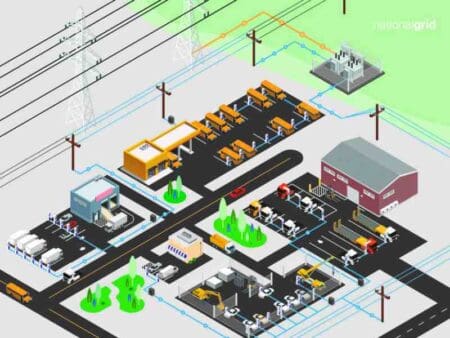
As widespread electrification of medium and heavy-duty vehicles (MHDVs) is expected to strain the grid, a new study from National Grid and Hitachi highlights proactive collaboration and strategic investment as key for power grid resilience.
The study, The Road to Transportation Decarbonization: Readying the Grid for Electric Fleets, was conducted jointly by the grid operator and the tech major to investigate the significant impact this electrification will have on the grid.
Namely, for the US grid to accommadate the much needed electrificaiton of heavy duty transport such as buses, trucks and vans, the study touts five key findings:
1: Region-specific strategy needed
According to the study, certain regions will experience grid impacts from MHDV electrification in the near future. Specifically, multi-megawatt charging loads from fleet clusters, or even a single depot, will quickly strain grid capacity in these areas.
As large fleets or states establish clear electrification targets or mandates, early adopters of electric MHDVs will place significant demands on the grid.
Utilities and policymakers must anticipate and prepare for these near-term loads and grid impacts, employing strategies tailored to each specific region’s needs.
2: Future-minded strategic investment
The study underscores the importance of coordinated investments in areas with high forecast electrification to minimise long-term costs and expedite electrification.
Namely, data, tools and forecast methods should be used to identify priority investment areas as well as locations requiring minimal, or deferred, infrastructure upgrades; these areas can then be aligned with fleet electrification and utility investment plans.
Have you read:
Are Europe’s distribution grids ready for heavy-duty EVs?
Network of hydrogen stations for heavy-duty vehicles in Europe
3: Updating regulation
The research highlights the necessity for evolving regulatory and planning structures to accommodate MHDV electrification.
According to the research, the majority of the electric load scenarios identified fall outside the scope of typical utility planning and regulatory processes. It is thus crucial to develop anticipatory planning and investment processes and regulatory mechanisms that can adapt to the rapidly evolving needs of electric MHDVs.
4: Grid infrastructure upgrades
According to the study, an optimal grid infrastructure strategy for MHDV electrification will vary by location.
Different infrastructure strategies, states the research, such as electric network reconfiguration, multi-value grid infrastructure upgrades, and non-wires solutions such as storage, can effectively support electric MHDVs depending on the unique circumstances and requirements of each location.
Stakeholders, it states, should thus consider the specific needs of each location when devising an infrastructure strategy, enabling utilities to invest in solutions that not only address immediate demands but also accommodate long-term charging growth.
5: Collaborative efforts
The study emphasizes the necessity for new forms of partnership and cooperation to facilitate the transition to electric MHDVs.
Such collaboration among fleet operators, MHDV manufacturers, utilities, and other stakeholders, states the research, will be crucial to coordinate investments, assess charging needs and overcome barriers to charging deployment.








